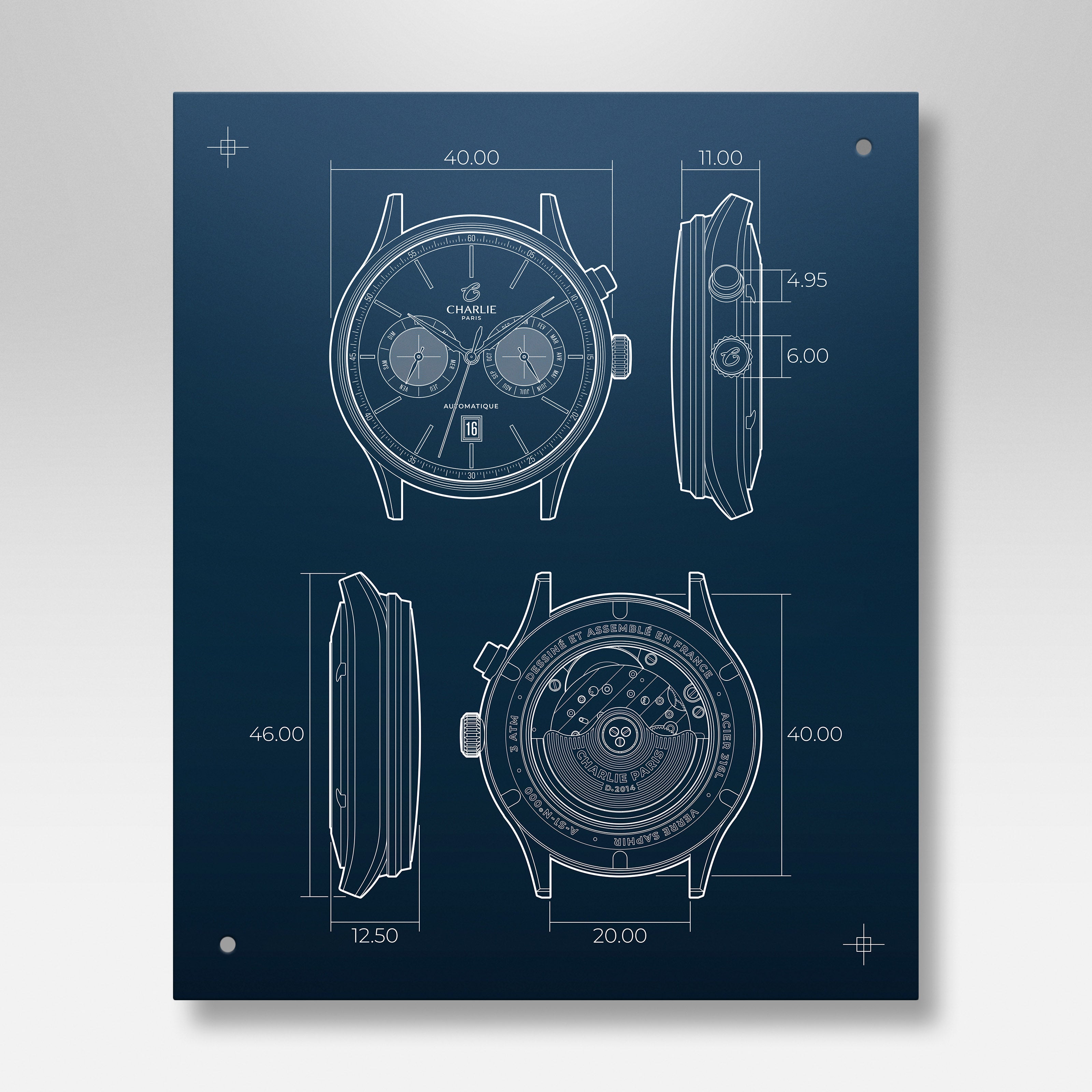
Everything you need to know about GMT watches
The term GMT may seem barbaric at first, but it is actually very simple to understand and it represents a very important part of watchmaking history. A watch collector must have a GMT among all his watches. Here is an article to familiarize you with this type of model so dear to watchmaking.
This complication has the particularity of displaying two or even three different time zones. Indeed, in addition to giving the local time, this very special timekeeper offers the possibility of reading the time of a second time zone thanks to a fourth hand and a flange displaying the 24 hours of a day. Often very distinguishable from the first hour hand, the hand of the second time zone sports a color contrasting with the rest of the watch to identify it at a glance. But let's not reveal too much right away and return to the history of so-called "GMT" watches and why they are so popular today.
The origin of the term “GMT”
To better understand this strange nickname, we must go back to the origins of the term GMT. It comes straight from the language of Shakespeare, meaning Greenwich Mean Time. Once translated literally and with a certain barbarity, it gives us: "Greenwich Mean Time". In reality, we must see behind these three somewhat strange words, a technique for calculating time, namely the mean solar time at the Greenwich meridian. This is the meridian that crosses the Royal Observatory in Greenwich, on the outskirts of London in the United Kingdom (we recommend this little detour, you will discover a magnificent park and a fabulous Maritime museum with a bonus of a superb panoramic view of the surroundings of the world city).
Today, the Earth is divided into 24 time zones, but it should be noted that this was not always the case. For hundreds of years, each part of the globe had its local time, based on the orientation of the sun. The arrival of railways and various technical advances allowing cross-border travel over much greater distances made these time zones a real headache that had to be simplified. It was then necessary to introduce uniform time zones across the world. Thus, Greenwich Mean Time served as the time reference in the world for most of the 20th century, before being replaced by Coordinated Universal Time (UTC) in 1972. Originating from the world of navigation, GMT made it possible to divide our planet from East to West by creating an arbitrary boundary (the meridian) in order to read geographic longitudes.
Please note that our good old GMT is based on the Earth's rotation while UTC is based on international atomic time. The calculation of time is therefore much less precise with a GMT-type evaluation technique. But don't worry, today when we talk about GMT complication, there is no link with the precision of watches. This term has simply remained in the common watchmaking language, to designate these very practical watches, but watchmaking rigor comes from the movement! Be careful, however, the term GMT is not universally adopted by watchmaking companies either. Indeed, it is not uncommon to see brands like SINN (German company) affix the acronym UTC instead of GMT.
Now that we have gone back in time and better understood where the term GMT came from, it is necessary to tell you about GMT watches and their much-loved complication. The wearer of a watch of this type can know the exact time of two time zones as specified in the introduction of the article. The reading of the two time zones is done on the same dial and is facilitated by color schemes on the hand and the flange. The fourth hand works like that of a 24-hour watch, pointing to the flange dotted with all the hours of a day. It is independently adjustable directly via the crown, although it can also be linked to the hour hand.
The GMT watch has therefore established itself in the watchmaking world as the accessory of choice for any good globetrotter. Indeed, wherever he is, the seasoned traveler with a GMT will be able to know the time in his home country and the time in his host country at a glance. It was for this precise purpose that the first GMT watch was created in the aftermath of the Second World War. At that time, international travel was on the increase and it became essential for pilots to know the exact take-off and landing times of their flight without cluttering the view of their cockpit with several time indicators. Frequent travelers will increasingly be tempted by this complication, so useful during their epics: knowing the exact time at home to call a family they miss without waking them up, sending a business email without seeming rude, not being late for a visit or an appointment because you forgot to set your watch to the right time zone... In short, with such a complication, two time zones on your wrist, it limits the risk of problems and makes life much easier. And then, my goodness, isn't it wonderful to have four hands on the same dial?
A GMT is often recognized by its famous two-tone bezels, and for good reason! They were created to make it easier to distinguish between morning and afternoon by reading the time in the second time zone. They have given their nicknames to iconic watches that we will talk about later, such as the "Pepsi" or the "Coca-Cola".
What about the third time zone?
If your GMT watch has a 24-hour rotating bezel, you can even use it to display a third time zone. Originally, this was an orientation aid for the GMT hand. However, with practice, you will quickly become accustomed to reading it without the bezel. Once you have mastered reading it, you can move the bezel to indicate a third time zone.
HERE ARE SOME BENEFITS OF OWNING A WATCH WITH GMT FUNCTION
As you will have understood, if you are a great traveler, this function allows you to keep a nostalgic eye on the time at home and to understand why you are completely jetlagged with the second time zone!
But here's a recap of what you can expect from your GMT:
The two-tone flange displaying the 24 hours of the day allows you to distinguish morning from afternoon.
- The GMT brings real added value to your watch from a technical point of view. It is indeed an interesting, complex and beautiful complication to observe in motion. If you want more information on this subject, take a detour to our article about the C125 from Soprod , a little gem…
- An elegant and original accessory thanks to its varied dial colors which often catch the eye of passers-by.
- If you're a real MacGyver, GMT watches can be used as a compass (if you really use it that way, we'd like a tutorial at Charlie Paris).
OUR GMT SELECTION
-
The Concordia GMT collection from Charlie Paris is available in four distinct models: Kraken , Nazaré , Bleu Antarctique and Dune . Four interpretations of the same philosophy: offering a robust, elegant GMT watch designed for adventure.
Whether you are a diver, traveler or urban explorer, the Concordia GMT ticks all the boxes of a GMT watch… and a diver’s watch. Water-resistant to 300 meters thanks to its screw-down crown, featuring a red insert indicating its opening, it is also equipped with a unidirectional rotating bezel with a luminescent marker at noon. Its 40 mm case, light and ergonomic, fits perfectly on the wrist for optimal comfort on a daily basis. Its two-tone flange allows an intuitive reading of the second time zone, while its fourth hand stands out from the others with a unique shade.
Each variation has its own personality. The Concordia GMT Kraken, with its deep black sapphire crystal dial and hypnotic reflections, evokes unfathomable abysses. The Nazaré, inspired by the mythical Portuguese wave, plays on blue and silver shades for an assertive marine spirit. The Antarctic Blue, classic and timeless, is a tribute to modern explorers, while the Dune, with its warm, sandy tones, recalls desert landscapes and distant horizons.
As always at Charlie Paris, elegance is combined with practicality. Thanks to its flash pump system, the Concordia GMT can be personalized in an instant with a steel, nylon, rubber or leather bracelet. A watch designed and assembled in Paris, which will accompany all your adventures, from the ocean floor to the summits of the world.
Thus, the GMT has managed to make its mark and continues to make lovers of timepieces dream. It was first to respond to a very specific technical problem that it appeared. Then it became democratized on the wrists of travelers around the world. To end up becoming institutionalized as an essential complication in the world of watchmaking. This was the story of the GMT.















Leave a comment
This site is protected by hCaptcha and the hCaptcha Privacy Policy and Terms of Service apply.